(v12.14.14)
Art, Architecture and Design in Columbus, Indiana
This article spotlights a particular building or some other aspect of Columbus design. I welcome your comments, corrections and additions. Please share your experience and perceptions of these uniquely Columbus projects.
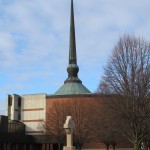 St. Peter’s Lutheran Church
St. Peter’s Lutheran Church
- Built: 1988
- 719 5th Street
- Design Architect: Gunnar Birkerts (Birmingham, Michigan) (NYC)
- Contractor: Force Construction (Columbus, Indiana)
- Addition to the adjacent Lutheran School: 1988
- Architect of school addition: David Force
St. Peter’s Lutheran Church goes back to the early days of Columbus history. This congregation was started in 1858 by 5 families from the even older St. Paul’s congregation on the outskirts of Columbus. A small wood frame structure at the corner of 5th and Sycamore was dedicated on July 22nd, 1858. A larger brick structure was built in 1871 and in 1904 an even larger building was constructed to serve 950 baptized members. During construction, the congregation held services at the nearby City Hall building at 5th and Franklin. The new structure was dedicated on June 19th, 1904. Despite the new sanctuary that was completed in 1988, this older 1904 building remained as part of the church complex until its removal in 2011 due to deteriorating conditions.
There has been a long history at St. Peter’s of providing a proper Lutheran education to their youth. A still standing 2-story 1941 building replaced the original 1887 school along 5th Street. Additional school space was added in 1950. Memorial Hall was completed in 1964 and was used as classrooms, gymnasium, kitchen and cafeteria as well providing space for church offices. These two buildings are still in use. With future expansion in mind, by 1979 they had acquired the entire 3 block area between 4th and 5th from Pearl to Chestnut Streets. Permission was received from the city to vacate their portion of Sycamore Street in the middle of the property whenever the future expansion plans were executed.
By 1983 with the total congregation numbering at more than 2600 members a decision was made to build a new sanctuary as the 1904 building had a capacity of only 500. It was during their 125th anniversary as a church that they engaged architect Gunnar Birkerts to begin designing their new building. Birkerts had earlier designed the Lincoln Elementary School across the street from the proposed site in 1967. It was hoped that he would create an equally pleasing structure for them and create a compatible environment along the 5th Street corridor. The church was sited to share a secondary axis with the center of the Lincoln School. The buildings form also reflects the multi-layered geometry of Lincoln. Birkerts was known for his innovative methods of bringing natural light into a building and there is no better example of this than the light filled interior of St. Peter’s.
Birkerts design was completed in 1988. The structure added another prominent landmark on the Columbus skyline with its 186-foot copper-clad spire. The spire is heavily influenced by the traditional church spire form found in Birkerts’ native Latvia. Although Birkerts’ said it was an unplanned coincidence, there is an amazing view of this church spire as you head towards downtown on State Street. The building is constructed of reinforced concrete, clad in brick and copper. A brick color was carefully chosen to be compatible with existing buildings along 5th Street such as Lincoln School and the library. Inside and out, the building features an interesting blend of flat and curved surfaces. Birkerts often liked to present buildings as a duality of opposites. Here we see the orthogonal and the curvilinear meeting suddenly in the geometry of the building. The back side of the building is very flat and linear, primarily concrete and bordering on brutilism. He calls this the masculine side and it presents its feminine side as you come around to the rounded brick portion of the building in the front. The front exterior is clad with brick with a series of windows beneath a copper fascia. The broken linear walls forming the south side are exposed and hammer finished structural concrete with brick banding. Birkerts’ view was that the irregular geometry of his design reflects the idea that sometimes nature’s imperfections are what inspire lasting humane architecture.
The roof is covered with an impermeable synthetic rubber with its cone overlaid with copper sheeting. Copper also overlays the ribs between the skylights, the bell sphere, and the spire. Supporting the roof and spire are steel I-beam trusses. The main girder which lies east to west is 109 feet long, 10 feet high and weighs in at 30 tons. The framework for the bell sphere and spire is made of high-strength aluminum beams. The spire was fabricated and copper-cladded on site, then positioned into place by crane. Now weathered into a natural patina, it was pure copper when first installed, reflecting the sun in sometimes blinding patterns. Braided 3/4 inch solid copper cables running from the aluminum framework of the spire to the steel roof girders and down the concrete walls to copper rods driven deep into the soil act as a lightning protection system..
The sanctuary interior is a blending of textured flat and curved white surfaces. Innovative natural as well as artificial lighting accents the interior. The white walls are set off by the textures provided by the maple furniture, maple doors and handrails, limestone and maple liturgical furnishings and a variety of other materials. Carpets are teal with teal and taupe wool seating fabric. All liturgical and interior furnishings were designed by Birkerts. Flooring was sealed concrete, carpeted in the open areas. The seating in non-concentric circles gives the feeling of a sanctuary within a sanctuary. Two off-axis circles create inner and outer sanctuary seating which allows the large worship space to be comfortably used for smaller gatherings as well as a full worship service. The worship space was designed to easily accommodate 1000 parishioners in the large rising open space without need for a formal balcony.
Windows on the north facing wall are long, narrow and deeply recessed in a unique pattern used as a design motif on the entrance doors and throughout the building. Dominating the south area of the sanctuary are massive fin walls with floor to ceiling windows allowing abundant natural light to enter the pulpit area.
Along the center aisle, directly beneath the spire, is a bronze plaque, inscribed with the May 1st, 1988 dedication date. Underneath lies a small vault containing a time capsule of special items and documents associated with the history of the congregation. This was the spot where the first construction stake was driven and from where all the initial measurements were taken. Other artifacts from the 1904 sanctuary were removed and incorporated into the new worship space including the organ, the bell, the oval marble altar top and the stained glass window of “Christ in Gethsemane.” Rising 186 feet above this spot on the finished floor is the copper spire topped by a cross. Underneath the cross is a small spherical time capsule. The larger sphere at the bottom houses the bell from the old sanctuary. Under the spire a skylight opens to the sanctuary featuring an 18-foot diameter light fixture that is also illuminated with spotlights reflecting light patterns from the intersecting planes of nickel mesh.
The chancel area is highlighted by a 12-foot high suspended maple cross which is illuminated by spotlighting. Underneath the cross is the altar made from two pieces of Indiana limestone, maple woodwork and the marble top from the 1904 sanctuary. The altar is in the center with the baptismal font to the north and the pulpit to the south. These three areas known as the “Three Means of Grace” are framed by a portable maple communion rail. An eternal candle burns on the back wall along with 7 elevated candles symbolizing the seven fruits of the Holy Spirit. A 24 channel sound amplification and video recording system occupies 2 large openings in the back wall. The interior of the sanctuary has many hard, sound-reflecting surfaces intentionally designed to create an acoustically alive space so that the organ, choral and instrumental music resounds to the fullest. Planters filled with greenery were placed high on the north and south walls.
Located in the upper level of the “outer sanctuary” is the Steiner-Reck pipe organ housed in a free-standing maple case. Designed by Gottfried Reck, the computerized organ fully incorporates the 1962 Holtkamp organ removed from the old sanctuary. This moderate-sized organ with a total of 66 ranks and 3,418 pipes contains an 8 foot polished brass horizontal trompete and 2 32-foot pedal stops. The 3 manual console features keys laminated with African benge (or wenge – a commercially-harvested, fine-grained, tropical hardwood from Zaire) and touch plate stops. Pipes in the organ are constructed of copper, zinc, tin and wood ranging from the size of a pencil to 18 feet in length. The upper area also provides seating for the choir, brass ensemble and handbell ensemble.
The narthex is a circular space as well to allow many people to be able to meet and interact before and after services. The narthex gathers people from the three entrances (from 5th Street, from the parking lot along 6th Street and from the interior hallway which connects the new sanctuary to the older parts of the church complex). Support areas leading from the narthex include restrooms, coat rooms, a cry room (equipped with a sound system and with windows looking into the sanctuary) and a bridal dressing room. The stained glass window of “Christ in Gethsemane” was mounted in the new narthex area. To get the children involved with the construction of their new church, it was decided to use their weekly chapel offerings to cover the cost. Maple cabinetry provides the setting for the window and also displays other historial church artifacts. Flooring in the narthex area is made of brick pavers laid in a decorative pattern extending from the central pillar. The church was designed in conjunction with a connecting wing of office and support space. This connector takes on the appearance of a cloister framing the green lawn space to the north.
Landscaping includes linden and river birch trees which dot the north side of the grounds with Bradford pear trees lining the south walkway. Groundbreaking for the church took place on June 22nd 1986 with the dedication and first worship service on May 1st, 1988.
In 2003 a major 57,00 square foot addition to the adjacent Lutheran school was added by local architect (and member of the congregation) David Force. As has been the tradition with this congregation they retained two older parts of the school which are still in use. The St. Peter’s Lutheran school is one of the largest in Indiana. The new school addition is connected to the rest of the school complex and sanctuary by an enclosed walkway. Force consulted with Birkerts to ensure a compatible design. David Force had become close friends with Gunnar Birkerts as his families firm, Force Construction, had been general contractor for the 1988 sanctuary construction. The same brick was used as in the 1988 construction to ensure a seamless addition. Exterior brick banding was repeated from the church continuing into the school lobby area. Interior spaces continue the primarily white walls and maple woodwork as seen in the church. Glass greenhouse areas are utilized to provide connectors between different portions of the church/school complex. A connection between the upper level of the church and the second floor of the school is accomplished by use of a glass bridge. The south facing façade is articulated with setbacks corresponding to the interior room arrangement allowing each major classroom to enjoy 2 window enclosures as well as providing an interesting exterior. The school addition was an opportunity to address accessibility issues as well as controlling access to the church and school. An elevator in the school addition lobby area serves the church as well as both new and older areas of the school building. Visitors should be advised that the main entry point to the church is now usually through the south facing school lobby allowing them to have better control over who enters the building while the children are in school. The highlight of the 2-story lobby is a large street style clock. The design of the new school also established a master plan for additions/upgrades to existing facilities to be carried out in a more consistent fashion.
In 2011 the former 1904 sanctuary was torn down due to its deteriorating condition. As many remaining elements as possible were retained to be used in future renovations/additions. The cross from the top of the 1904 sanctuary is now mounted on the lawn area where the old church once stood.

Front of church from 5th Street
(photo by Ricky Berkey)
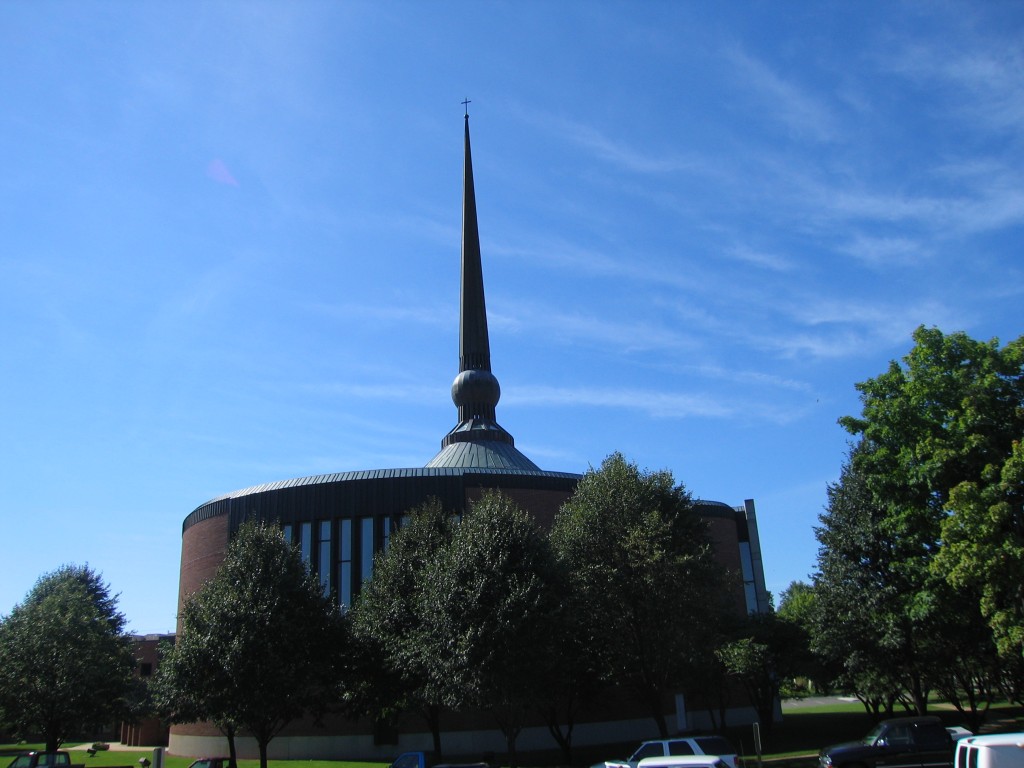
Front of church from 5th Street
(photo by Ricky Berkey)
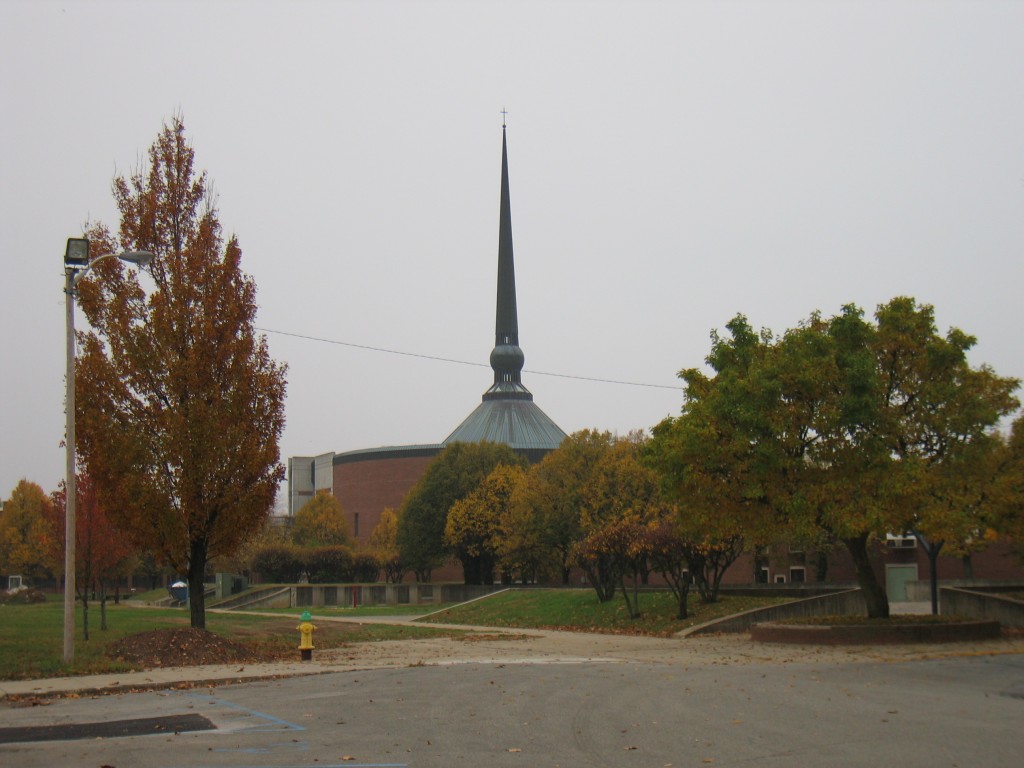
View from across 5th street on the other side of Lincoln school
(photo by Ricky Berkey)
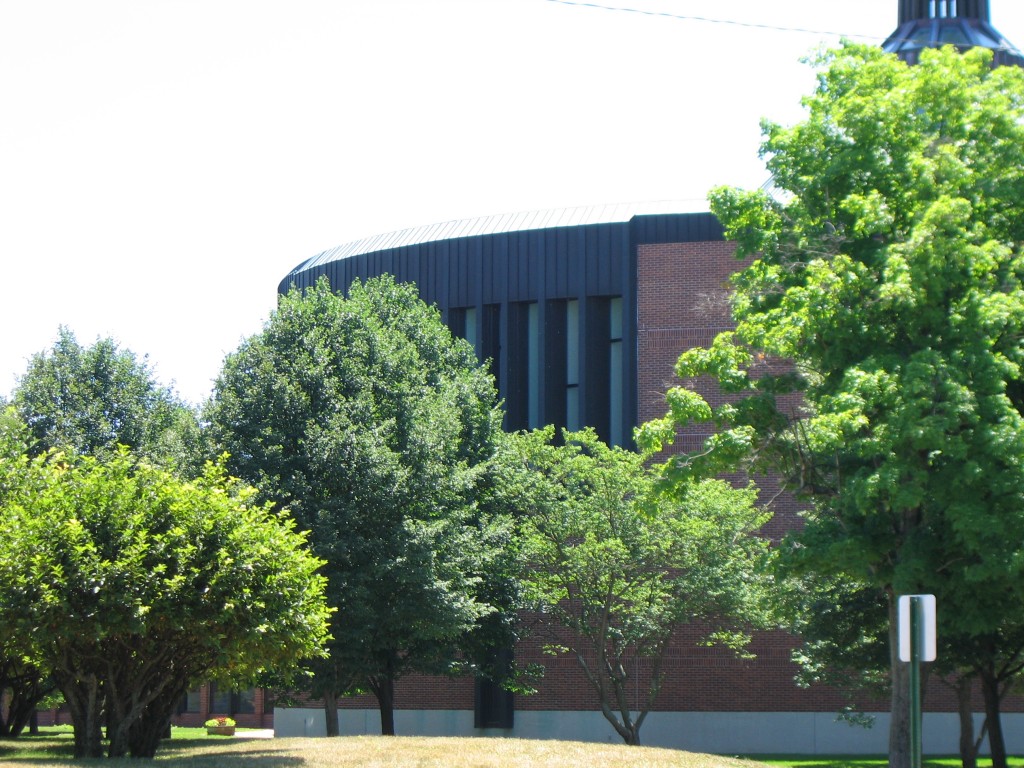
View from 5th Street
(photo by Ricky Berkey)
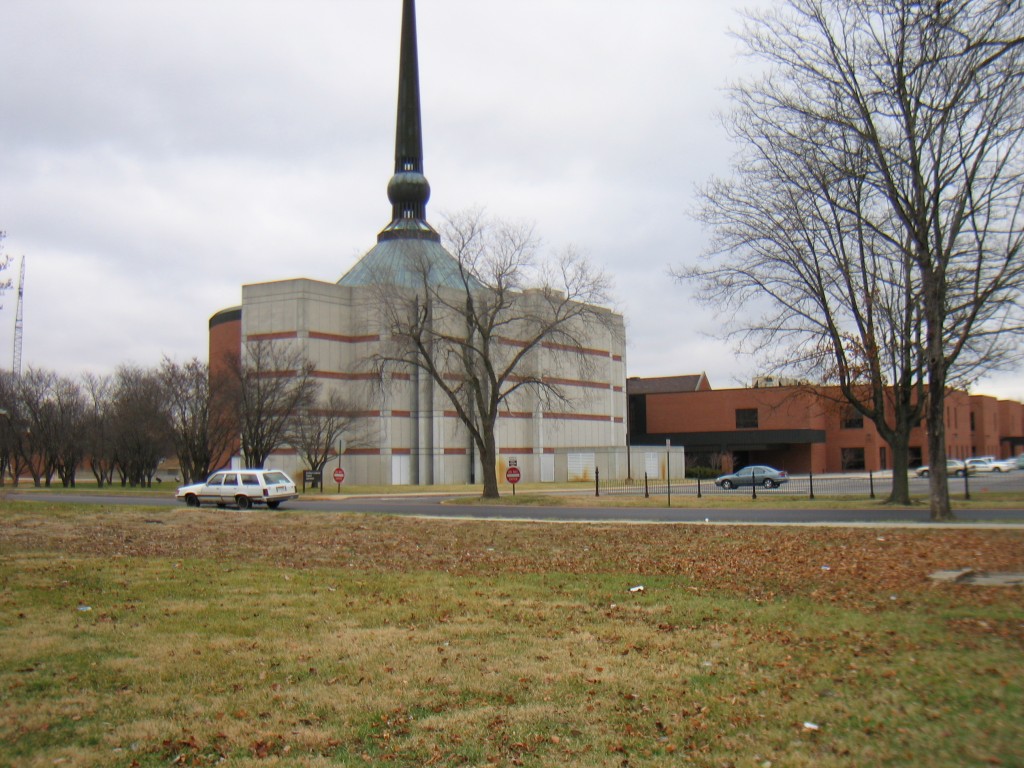
Rear view, 2003 school addition on the right
(photo by Ricky Berkey)

Rear view
(photo by Ricky Berkey)

Rear view
(photo by Ricky Berkey)
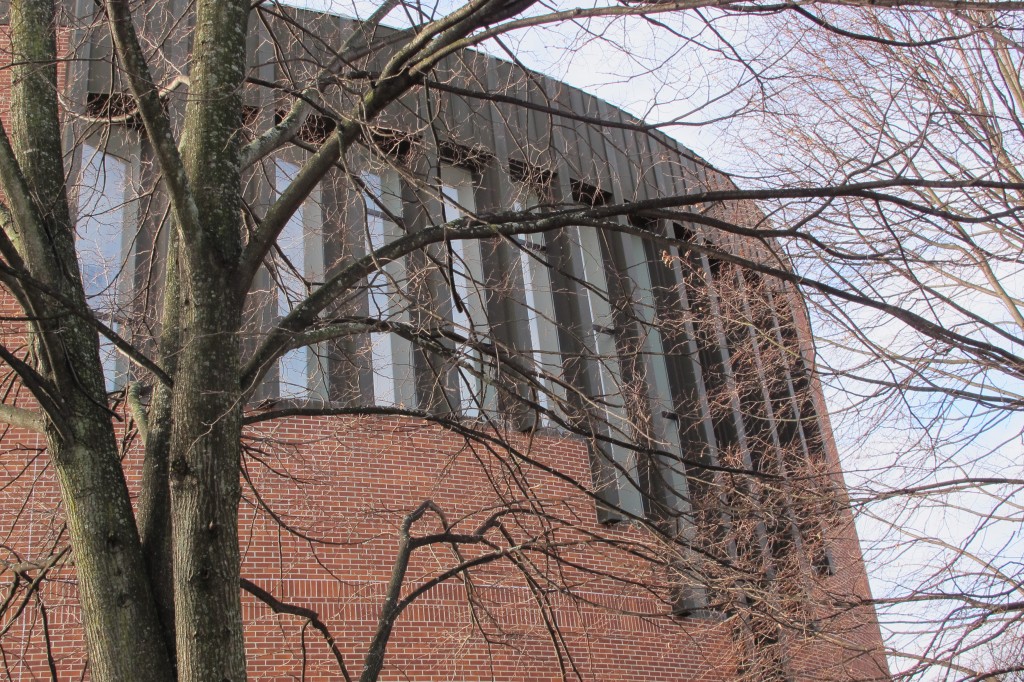
Windows on front side, this pattern is repeated around the building
(photo by Ricky Berkey)
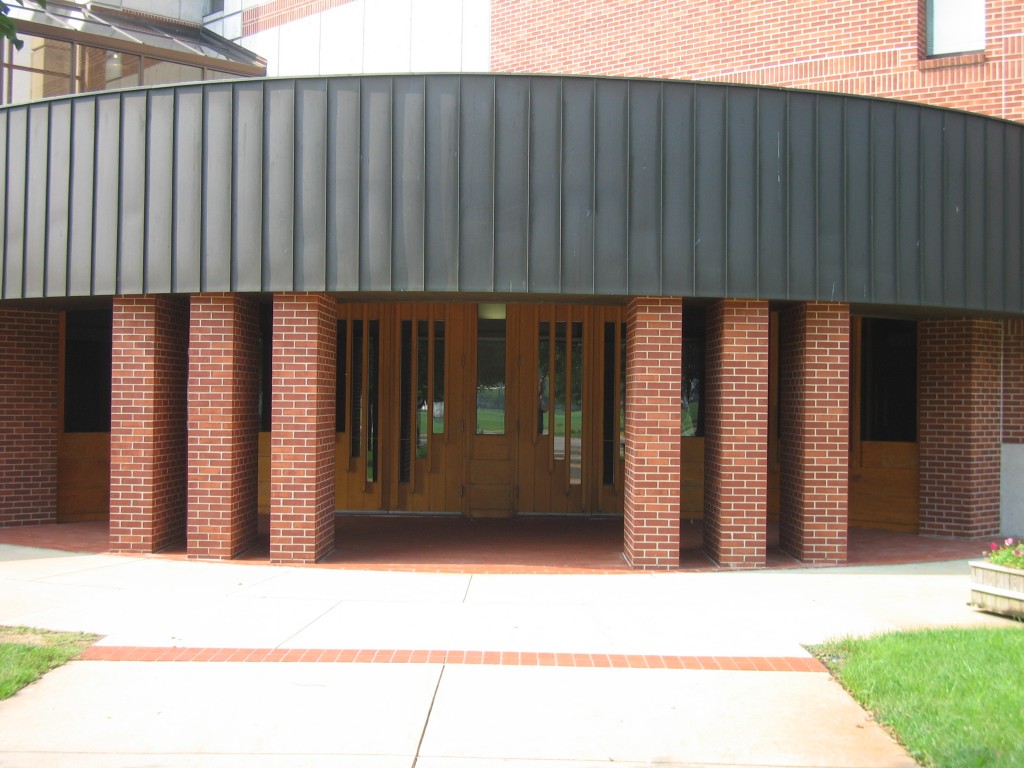
5th Street entrance, note the window pattern repeats
(photo by Ricky Berkey)
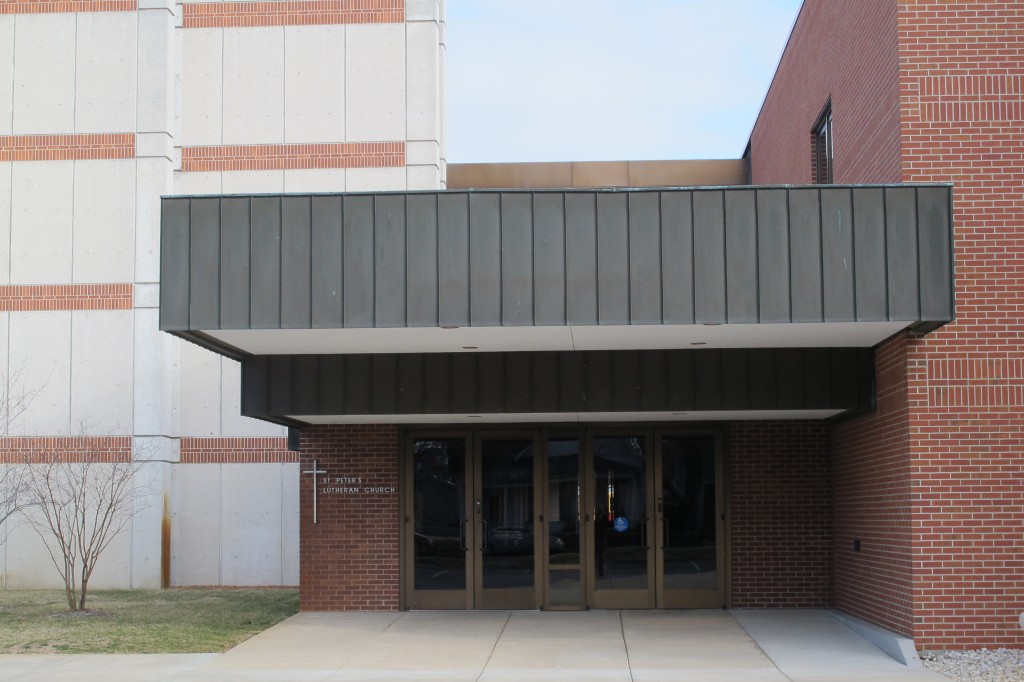
Entrance on 6th street side
(photo by Ricky Berkey)

5th Street Entrance
(photo by Ricky Berkey)
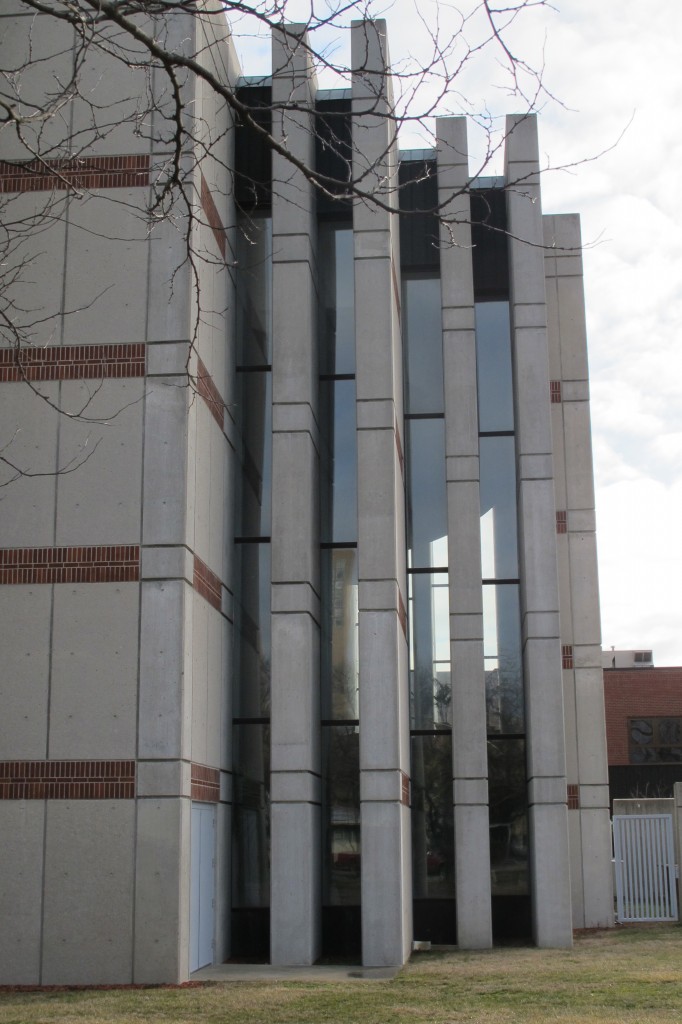
Tall slender windows bring natural light into the chancel area
(photo by Ricky Berkey)
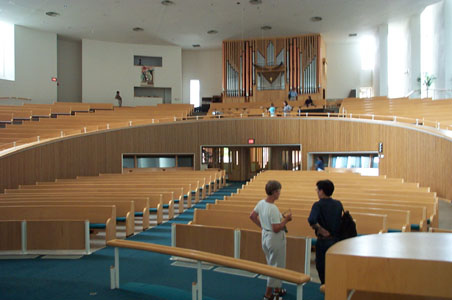
View from the pulpit
(photo by Terri Boake…used pending permission)
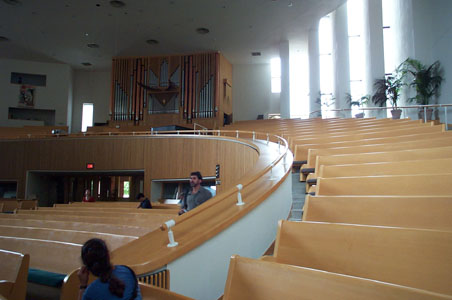
Sanctuary view
(photo by Terri Boake…used pending permission)
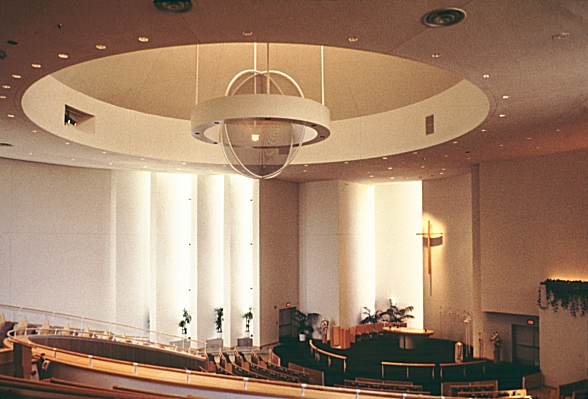
Sanctuary
(photo by Mary Ann Sullivan…used pending permission)
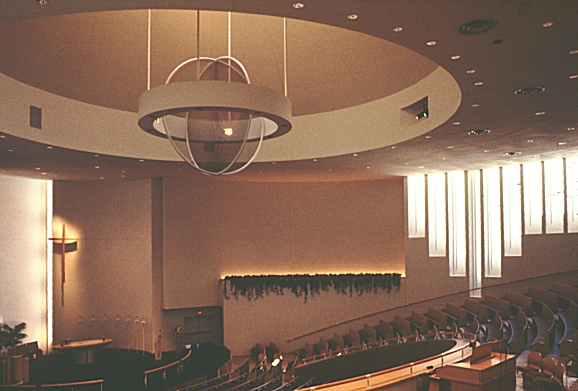
Sanctuary
(photo by Mary Ann Sullivan…used pending permission)
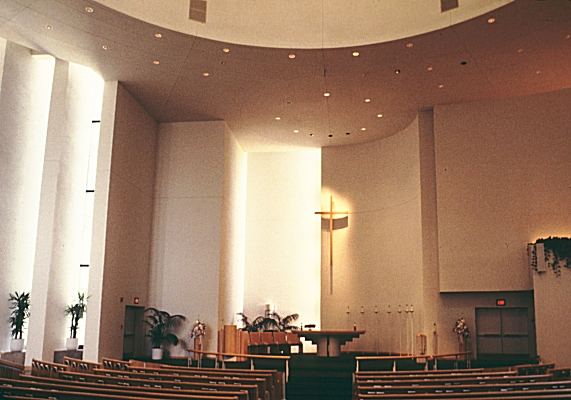
Sanctuary
(photo by Mary Ann Sullivan…used pending permission)
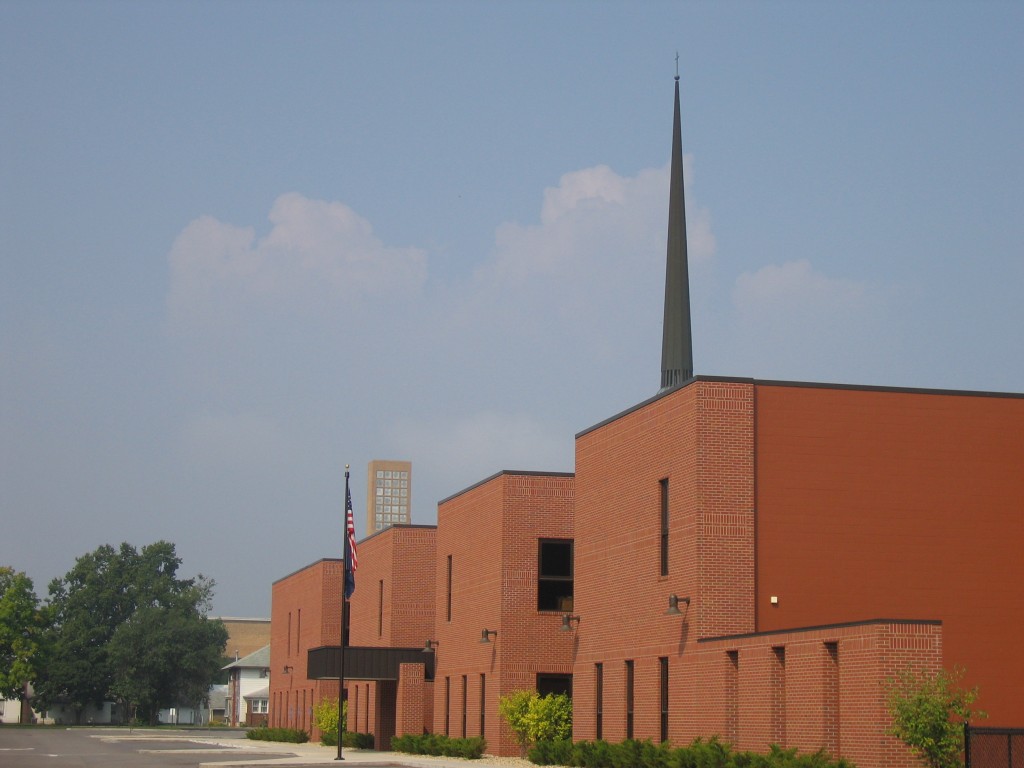
School addition by David Force
(photo by Ricky Berkey)

Gunnar Birkerts sanctuary on the left, David Force school addition on the right
(photo by Ricky Berkey)

School addition by David Force
(photo by Ricky Berkey)
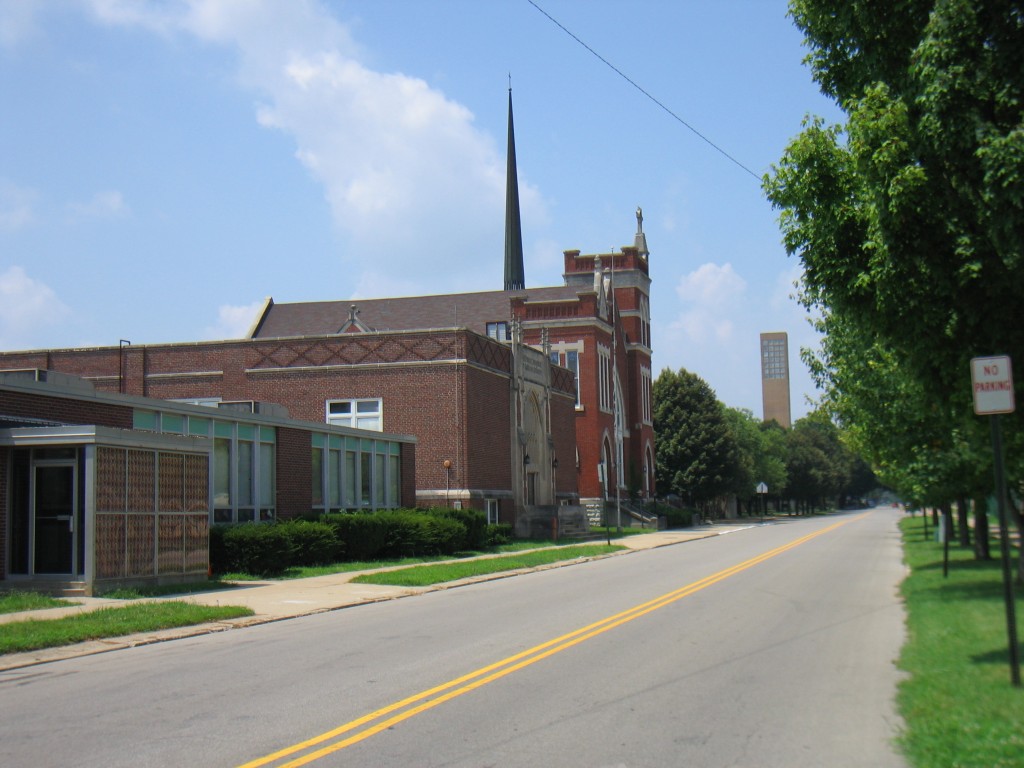
2 older school buildings on left are still in use, 1904 sanctuary on right now demolished
(photo by Ricky Berkey)

Cross on the lawn in foreground was from the top of the 1904 church demolished in 2011
(photo by Ricky Berkey)

Church spire, the lower ball contains the bell from the 1904 church, the ball just beneath the cross contains a time capsule
(photo by Ricky Berkey)
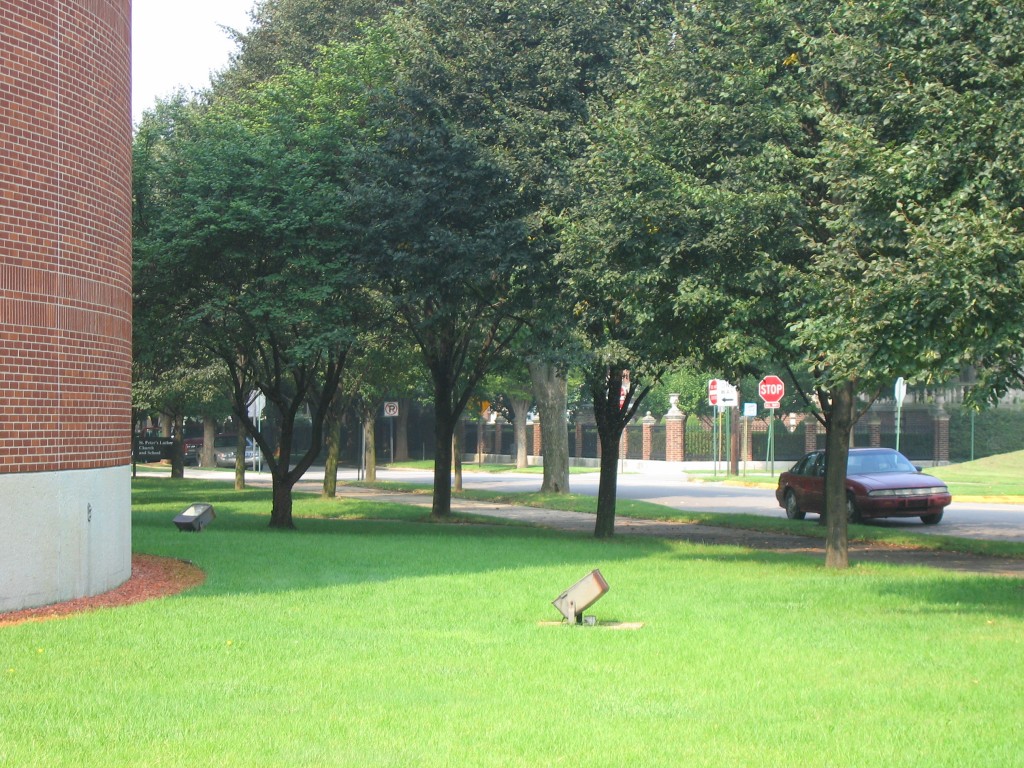
Landscaping
(photo by Ricky Berkey)
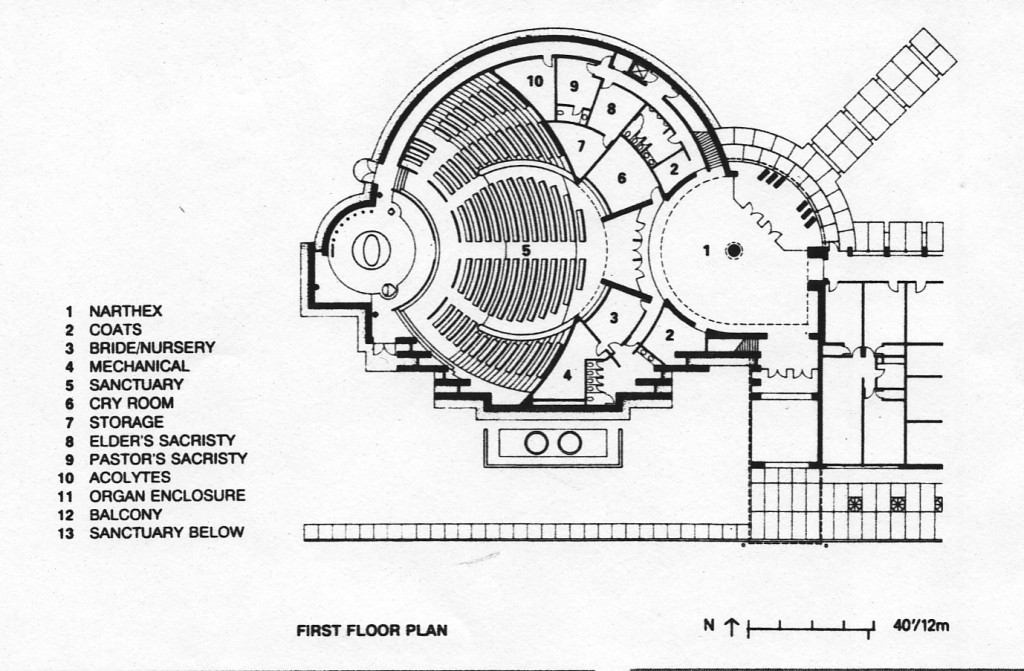
Lower level layout
(photo used pending permission)
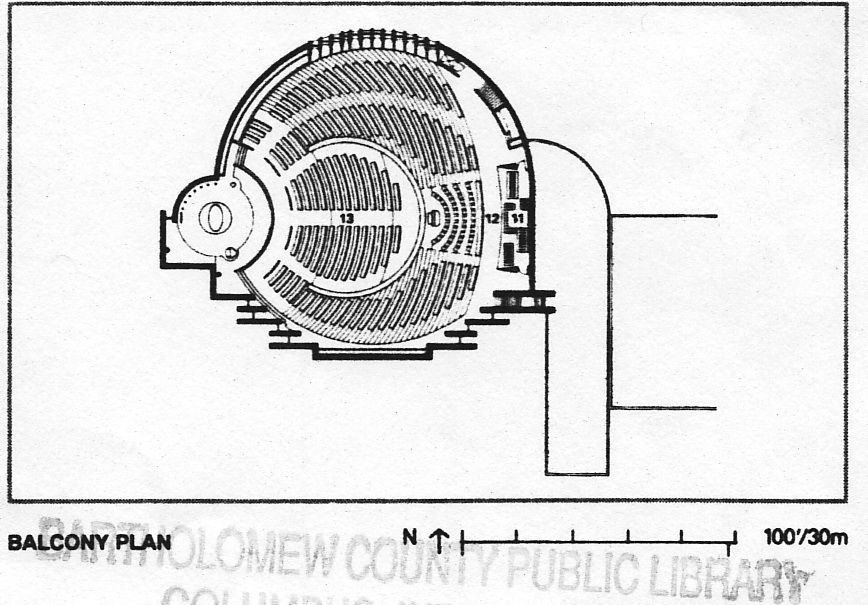
Upper level floor plan
(photo used pending permission)

Aerial view
(Google map view used pending permission)
The Architects
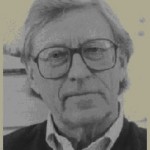 Gunnar Birkerts
Gunnar Birkerts
- Born January 17th, 1925 in Riga, Latvia
- Technische Hochschule (Stuttgart, Germany), 1949
Gunnar Birkerts was born and raised in Latvia but fled ahead of the advancing Russian army toward the end of WW2. He graduated from the Technische Hochschule in Stuttgart, Germany in 1949 with a degree in architecture and engineering before coming to the United States.
Birkerts worked for Perkins and Will in Chicago from 1950-51 before joining Eero Saarinen in Bloomfield, Hills Michigan. He became lead designer for Minoru Yamasaki in 1955 before opening his own office in the Detroit suburbs as Birkerts and Staub in 1959 which became Gunnar Birkerts & Associates in 1963. Upon opening his own practice he said: “my apprenticeship was over. Now it was my turn to speak”. Over the years he developed a reputation as one of our foremost modernist architects. His many projects include museums, corporate headquarters and government buildings for clients in the United States, Europe, and South America. He is noted for his expressive forms emphasizing dynamic flow and illumination of space. He often used lighting as a design element:
“reflected, diffused or directionally washed over an enclosing plane…can give enormous richness to an otherwise simple, uninteresting space”.
Gunnar Birkerts & Associates received Honor Awards for its projects from the American Institute of Architects (AIA) in 1962, 1970, 1973, as well as numerous awards from the Michigan Society of Architects and the local chapter of the AIA. The 1970 award was for our Lincoln Elementary School which was built in 1967. Gunnar Birkerts was selected as a Fellow of the American Institute of Architects in 1970 and a Fellow of the Latvian Architect Association in 1971. He has received numerous other individual awards in Michigan, the United States and his native Latvia.
Birkerts joined the faculty at the University of Michigan College of Architecture in 1959 and taught until 1990. He has also taught at the University of Illinois and the University of Oklahoma.
Birkerts is still active as an architect and now maintains an architectural office in Wellesley, Massachusetts.
Selected Gunnar Birkerts Projects
1966: Detroit Institute of Art, South Wing – Detroit, Michigan
1967: Lincoln Elementary School – Columbus, Indiana
1971: Detroit Institute of Art, North Wing – Detroit, Michigan
1972: Contemporary Arts Museum – Houston, Texas
1973: Marquette Plaza (formerly Federal Reserve Bank) – Minneapolis, Minnesota
1980: Corning Museum of Glass – Corning, New York
1986: Dominos World HQ – Ann Arbor, Michigan
1988: St. Peters Lutheran Church – Columbus, Indiana
1989: U.S. Embassy – Caracas, Venezuela
1994: Kemper Museum of Contemporary Art – Kansas City, Missouri
 David Force
David Force
- Born in 1956 in Columbus, Indiana
- Bachelor Degree – Architecture: University of Illinois at Urbana – Champaign , Illinois (1978)
- Unite de Pedagogique d’Architecture – Versailles, France
- Masters Degree – Architecture: University of Illinois (1980)
- MBA Degree: University of Illinois (1980)
David Force grew up surrounded by buildings and construction. His families construction business, Force Construction was started in 1946 and has left a legacy of quality building in the Columbus area. Force Construction is a full-service general contractor.
Born and raised in Columbus, David has remained in his hometown to pursue his career and raise his family. After receiving a Masters degrees in both architecture and business at the University of Illinois he joined the family firm, Force Construction. He started his own design firm, Force Design as a part of the larger family business in 1977. Force Design offers a full range of architectural and engineering services. He became the Executive Vice President of Force Construction in 1981.
Selected David Force Projects
St. Peter’s Lutheran School (2003)
St. John’s White Creek Lutheran Church and School
Toyota Industrial Equipment Manufacturing
ArvinMeritor: Columbus Technical Center
Home Federal Bank: Washington Street Branch
Historic St. Peters
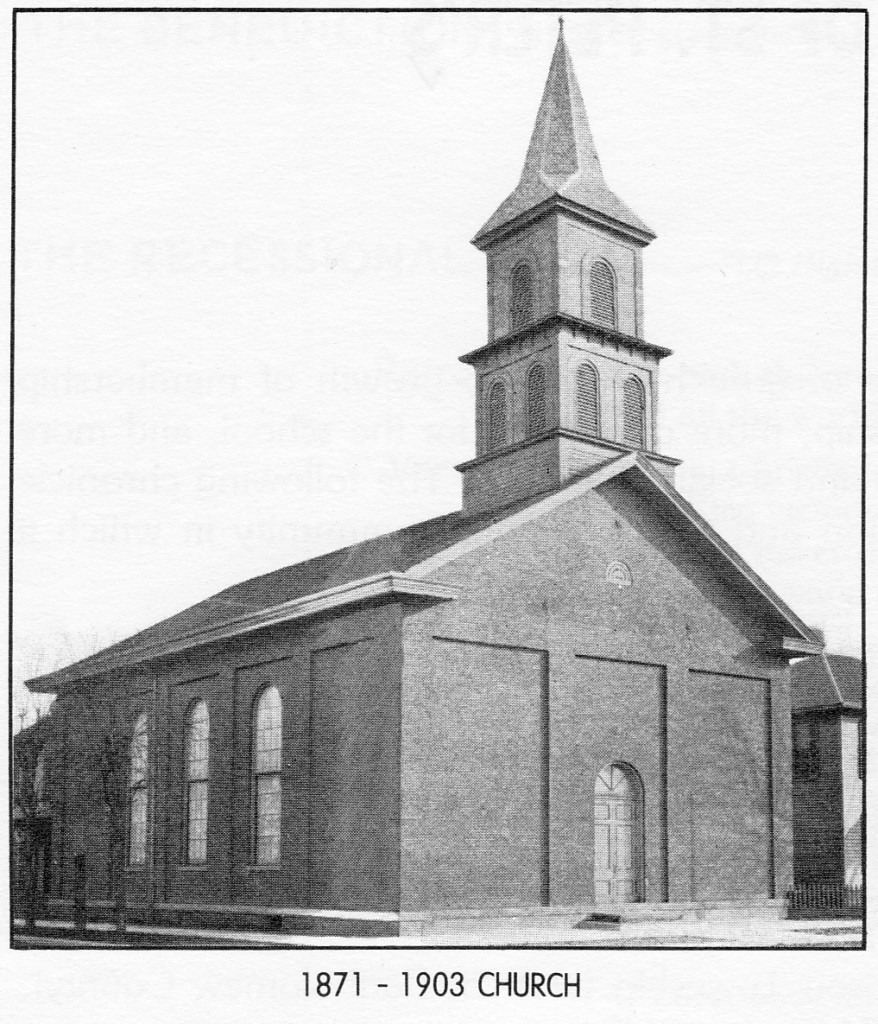
This is the 2nd St. Peter’s Lutheran church building
(photo used pending permission)
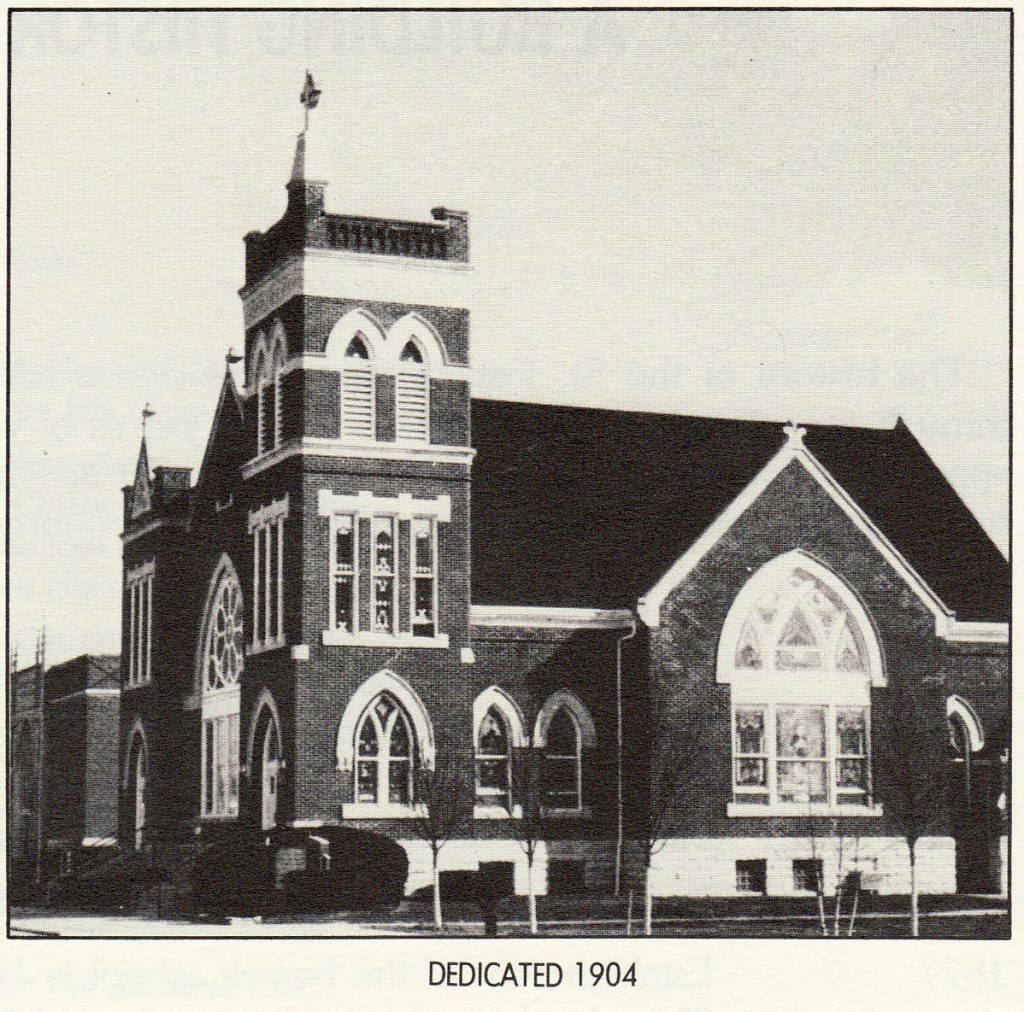
This is the 3rd St. Peter’s Lutheran church building
(photo used pending permission)
Links/References
Video tour of St. Peters on Utube: video by uTube user “wworldp”
3D Model of St. Peter’s Lutheran executed in Google Sketchup:
Gunnar Birkerts Architect Website
Gunnar Birkerts Archives (Bentley Historical Library)
Gunnar Birkerts Archives (Bentley Historical Library)
“The Architecture of Gunnar Birkerts” – book covering his career and projects from 1957-1989
“Gunnar Birkerts – – Metaphoric Modernist” – more recent (2009) book covering his career and projects
“Gunnar Birkerts: Buildings, Projects and Thoughts (1960-1985)” – book by Birkerts on his projects and design process (features a lot of his own drawings and models)
Force Design: David Force design firm
City of Columbus: official City of Columbus website
Columbus Indiana Architectural Archives
Columbus Indiana Architecture Digital Archives: A small portion of the Columbus Indiana Architectural Archives available online from the IUPUI digital library
3D Models of Columbus Architecture Executed in Google SketchUp:
The Republic Newspaper – Columbus, Indiana newspaper
Bartholomew County Public Library
Historic Columbus Website – David Sechrest’s tribute to Columbus History
Historic Columbus Message Board – a companion interactive forum to the David Sechrest historical website
Bartholomew County Historical Society
 Click HERE for a Calendar of Upcoming Events in the Columbus Area.
Click HERE for a Calendar of Upcoming Events in the Columbus Area.
Click HERE for information about Tours of Columbus Architecture and Design including the Miller House.
 Ricky Berkey
Ricky Berkey
Email me: rickyberkey@gmail.com

Hi Ricky,
What a fantastic job you’ve done compiling the great works of Columbus … So appreciated !!!
I’m giving a short talk regarding the Columbus approach to public projects THIS EVENING at the North Miami, FL Planning Commission. We’ll review a short primer that we found on YouTube.com, but might you have a data file that you could share with us that gives a quick tour of the 70 or so projects found about the community?
Thank you for your consideration … and sorry that I just discovered your website at this hour.
Best regards from Miami !
Bill
305.891.8888